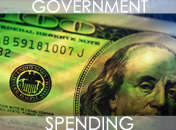
This report, compiled through the use of budgetary documents published by the Governor’s Office of Planning and Budget, analyzes state expenditures in seven categories: public education, higher education, other operations, health and human services, transportation, law and order, and capital and debt service. Changes in each category are analyzed by calculating a ratio of government spending per $1,000 of personal income, which roughly illustrates the proportion of Utahns’ earnings that are dedicated to funding state government.
Examining spending changes shows total state expenditures per $1,000 of personal income were declining steadily from the early 1990s until Fiscal Year 2007. This does not mean the actual dollars of spending decreased in those years, but that the increases in spending were slower than the increases in Utahns’ incomes. This trend changed in 2007 and 2008, as surplus revenues from the economic boom were spent on state programs. However, spending has declined significantly since Fiscal Year 2008, as the economy fell into a deep recession. Nevertheless, the declining state economy has not resulted in across-the-board cuts in Utah’s public services, as the proportion of personal income dedicated to certain categories and departments, such as Workforce Services and the Labor Commission, actually increased during this period.
Although federal funds are not factored into this report’s calculation of state-level expenditures per $1,000 of personal income, they are, nevertheless, critical to the state’s budget. Since FY 2009, federal funds have become larger than the other two main funds in Utah’s budget, replacing the Education Fund as the number one source of revenue. The influx of federal funding seen since the recession is a temporary phenomenon, made possible by the federal stimulus packages. Federal funds have been critical to categories such as other operations and health and human services, supplementing declines in state funding.

